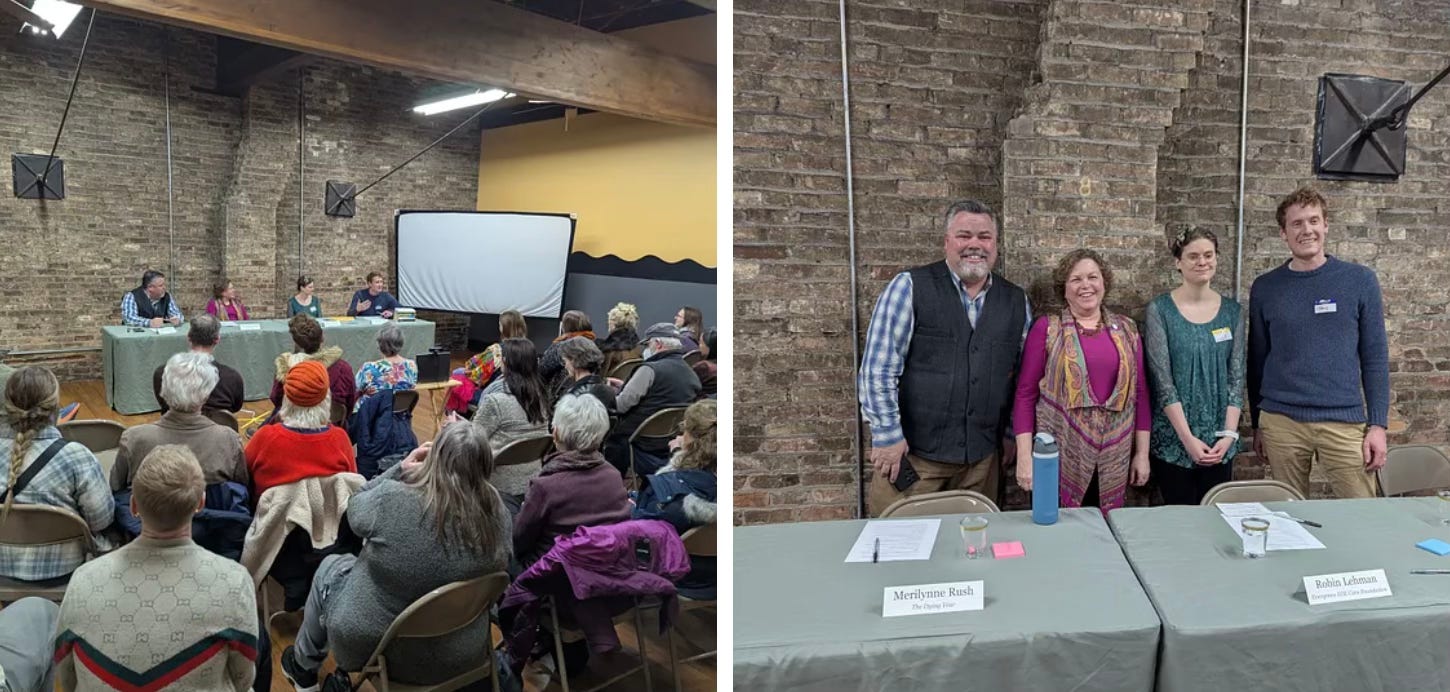Greetings Neighbors and Strangers,
You may remember, a little over two months ago, I shared with you all about an art exhibit in Jackson, Michigan titled “Soul to Soil.” As a part of the opening night, I had the privilege to share about natural burial and Jeremiah Commons. The exhibit was a success! And I hope my message was well received. Following my talk, I was grateful to sit on a panel with several folks who I look up to in this work of educating others about the benefits of natural burial. I’ve included a few pictures of the night taken by the wonderful folks of the Michigan Deathcare Collaborative.

An update
In other news, a few more wonderful folks have joined Jeremiah Commons’ Board of Directors and the recent months have been filled with great conversations chewing on our plans for 2025. Our two commitments for both funding and community outreach this year are 1) to focus on developing operational capacity in these early stages as we continue sharing our vision and search for land and 2) to continue educating and connecting the local community around natural burial and its benefits. If you’d like, you can donate to either of these two efforts or you can reach out to me at this Google Form if you have an opportunity to share about natural burial with friends you know or strangers you don’t.
Natural burial: A natural choice
It would be hard to distill in a short blog post all of the benefits of the thoughtful and meaningful practice of laying loved ones to rest free of any non-biodegradable materials.
There are many paths into the appreciation of these ancient, simple, and intimate practices. Indeed, the fact that there are so many reasons to appreciate natural burial is, ironically, another path that has drawn me to these practices—they are, quite literally, for everyone.
Some folks, especially those with roots in agricultural communities, would like to be buried how their grandparents were buried—in a simple box near the land that supported their life. It is a return to tradition—reclaiming practices and ways that humans have buried their loved ones for as long as we have been around.
For others, because natural burial is often accompanied by simple burial furniture (shrouds, wooden boxes, woven caskets), no formalin is used, and the home is often utilized, the costs can be much lower than traditional burial costs, even less than cremation.
Still others, myself included, find the act of removing any impediments to our return to the soil—the soil that has sustained our lives—laden with deep spiritual significance. For perhaps most folks drawn to these practices, however, the environmental benefits of natural burial are what truly pique their interests.
Every year in America, with burial vaults alone, we put in the ground 1.6 million tons of concrete and 64,500 tons of steel. That is equivalent to burying almost two Mackinac Bridges, America’s longest suspension bridge by total length. Add caskets and embalming practices and we bury 20 million board feet of hardwoods, including rainforest woods, and 4.3 million gallons of embalming fluid, 827,060 gallons of which is formaldehyde, methanol, and benzene. That is enough embalming fluid to fill almost six Olympic-size swimming pools. Flame cremation can require up to 500 gallons of fuel per person (though typically around 50 gallons) and, depending on any dental amalgams or internal prosthetics can release mercury and other particulates in the surrounding breathable atmosphere. (Sources below.)1
In contrast, natural burial forgoes the use of nearly all of these materials so that whatever is buried can return to nature. The sustainable practice sequesters 25 lbs of CO2 per burial, nourishes the local soil community with nutrients through natural decomposition, and can even beneficially disturb the soil to promote native plant growth, just as a fallen tree in the forest might. Conservation cemeteries implement these practices on a larger scale, preserving space for wildlife to roam and flourish, native vegetation to grow, and space for humans to rest and delight in nature.
I feel confident in saying that, when done correctly—that is, paying attention to soil types, implementing best practices for soil removal and replacement, following proper health codes, and paying attention to relevant scientific literature—natural burial results in the least environmental impact and is the safest method for the surrounding living communities.
Conservation cemeteries create a space towards which all of the paths of interest into natural burial can converge. They are spaces for everyone, to use Robin Wall Kimmerer’s language, to “restore the land and our relationship with it.” They are spaces of great religious and spiritual significance. They are spaces where the community can come together for celebrations of life, and life-giving practices.
If any of these reasons resonate with you, or if you’d like to join the effort to create a space where everyone can have access to these ancient and beautiful practices, then please reach out or share a gift. I’d love to connect with you.
Be well,
Tony
https://www.greenburialcouncil.org/disposition-statistics-media.html
(This subreddit and infographic has a lot of helpful, user-friendly information) https://www.reddit.com/r/Infographics/comments/n14u0y/comment/gwaom98/?utm_source=share&utm_medium=web3x&utm_name=web3xcss&utm_term=1&utm_content=share_button




